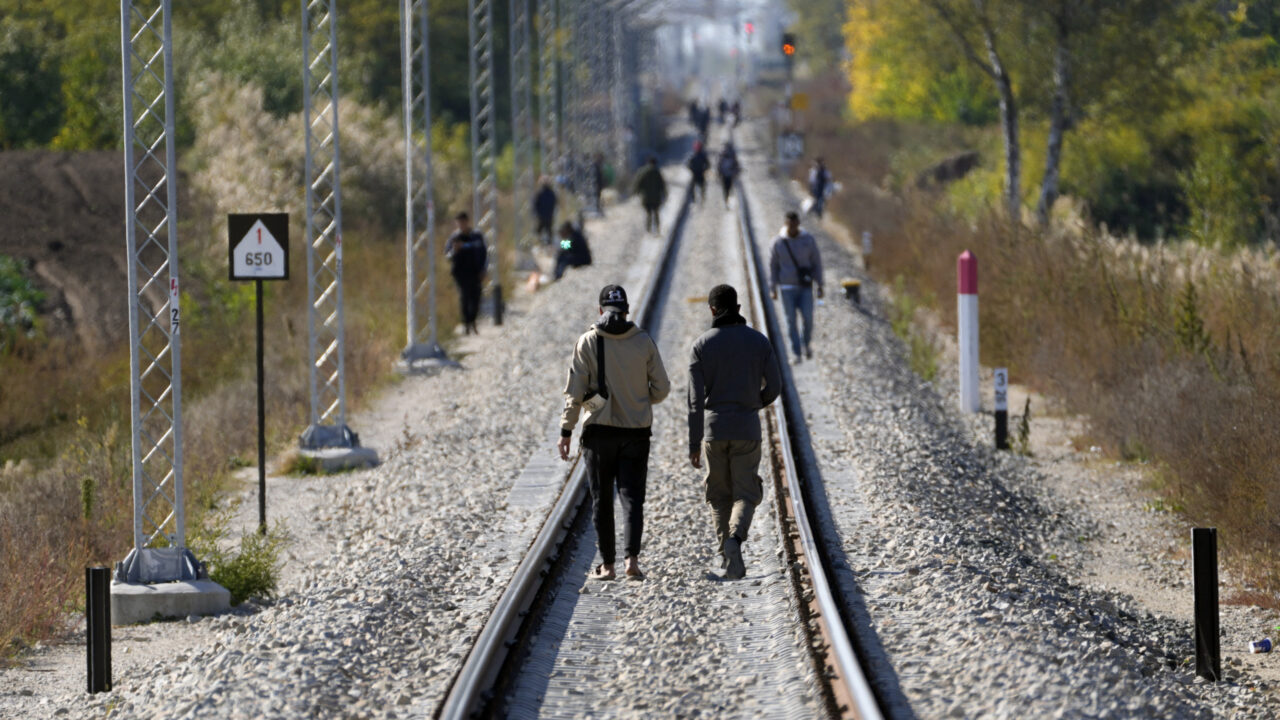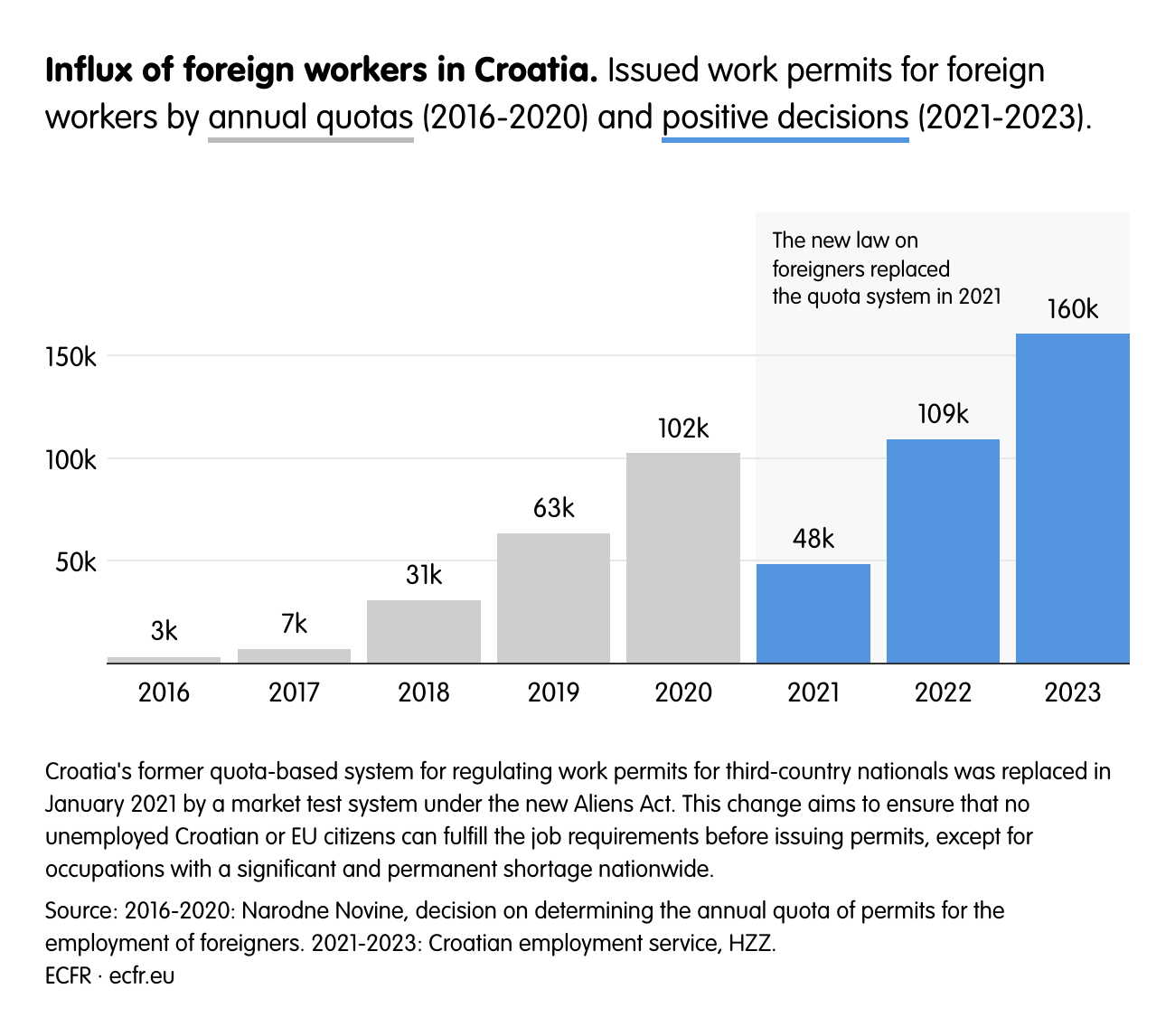Depopulation blues: How immigration can counter emigration in the Balkans
To tackle the political and economic challenges posed by shrinking populations, Balkan governments need to approach immigration as an opportunity, rethinking their policies and political messaging
“This is a golden opportunity if you are looking for a job abroad. Don’t hesitate and apply to make the most of it.” With these words, Croatian agencies for bringing in foreign workers present their offer to workers from Nepal. In recent years, such invitations from Balkan countries have become widespread. Their governments hope that increasing immigration may partially offset the region’s burgeoning problem: mass emigration and low birth rates leading to depopulation.
In 2022, Serbia’s population fell to 6.6 million, over half a million fewer than it was a decade before. UN projections estimate that its population could decrease to 5.77 million by 2050 and to 3.26 million by the end of the century. In neighbouring Bosnia and Herzegovina, more citizens live abroad than in the country itself, and predictions suggest the working-age population will halve by 2050. In North Macedonia, between 2002 and 2021, one in five under the age of 29 emigrated, decreasing the average working age by more than 12 per cent. Similar figures can be found throughout the region. Even Kosovo, with a median age of 29, faces huge demographic challenges.
In the past, the Balkans received relatively few immigrants and labour shortages were filled from neighbouring countries. Typically, Albanians, Bosnians, and Serbians would work as seasonal workers in neighbouring Croatia, for example. But as the emigration crisis has become more severe in recent years, foreign workers are coming from further afield, causing huge demographic shifts – and political upheavals.
In Croatia, the influx of foreign workers, notably from Nepal, has surged dramatically. Last year, nearly 15,000 Nepali workers immigrated to the country compared to just 4 in 2017. This year, the number of registered foreign workers could reach almost 200,000 with estimates suggesting that by 2030, every fourth worker in Croatia could be a foreigner.
The rest of the region tells a similar story, both EU member states and aspiring. In 2024, the Romanian government raised the annual work permit quota by 40 per cent to 140,000. In both Romania and Bulgaria, a significant percentage of immigrants work in industries that often face labour shortages such as agriculture, construction, healthcare, hospitality, and technology. While many Ukrainians (primarily women and children) seeking refuge in neighbouring countries has helped address some of the labour shortages in the service industry, levels are far from sufficient. To cope with growing labour shortages, North Macedonia needs at least 10,000 foreign workers annually, according to the country’s deputy prime minister for economic affairs – double the amount of work permits issued last year. Last year, Montenegro issued 27,700 work permits for foreigners, nearly double the 2016 figure. In neighbouring Serbia, the number of foreign workers that came in the first half of 2023 rivalled the total figure for 2022.
Despite significant immigration figures, there is a noticeable lack of strategic thinking and thorough migration planning from Balkan governments. Emigration rates remain high due to a vicious cycle where poor economic conditions are exacerbated by governments’ failure to implement policies aimed at improving these circumstances and enticing people back home. This then further worsens labour force shortages and the capacity of public services, while leaving small labour markets lacking investment in industries that could spur growth and draw people back.
To fill in the gaps, simply importing people is not enough. Government policies have done little to address systemic issues, and rather than focusing on growth, strengthening ties with emigrants, and creating attractive educational and economic opportunities to encourage their citizens to return, governments and trade unions have increasingly relied on foreign labour without any guiding strategy. As a result, language, cultural, and legal obstacles hamper immigrant integration into labour markets and society more broadly. This has sparked debates over immigration policies, lack of integration, and concerns of national identity being at risk.
A recent survey indicated that immigration will be a significant political issue for Croatians in coming years: half of all Croatians believe that immigrants are a threat to their culture and way of life, and only 24 per cent support their arrival. Croatian respondents also expressed concern about the need to use English in local establishments, leading to a growing sense of unease. For foreign workers in the country, conditions are poor, and there have been cases of violence against them including thefts and beatings.
The lack of a systematic approach to integration leaves the region’s direction to chance: the moment foreign workers are perceived by locals as competition for jobs, support for immigration will, and already has, waned in favour a homogenous society. But a homogenous society will only worsen the regions demographic woes.
Currently, effective integration programs, covering employment access, language skills, and cultural adaptation, remain scarce. Policymakers need to distinguish between immigrants from neighbouring countries with shared cultural ties, and those from other regions, and their differing needs for successful integration. (As previous ECFR studies show, narrower cultural differences between citizens and migrants from neighbouring countries makes their absorption in labour markets smoother.) Governments should also invest in integration programs, offering language training and support services, to ensure smooth integration of foreign workers, who intend to stay in the region.
Studying successful immigration policies elsewhere can help address such demographic challenges, prioritising economic needs and social integration. For example, the liberalisation of immigration policies across Europe have often proved successful in growing labour markets. Germany’s immigration policy fills gaps in sectors like innovation, healthcare, and technology, boosting the country’s economy. Learning from this, to capitalise on the current influx of foreign workers, governments in the Balkans should develop robust immigration policies that cater to specific labour market demands, and safeguard foreign workers’ rights. Policymakers could create specialised-worker visa schemes that target industry gaps. Unions should also ensure fair wages and safe conditions for all workers and labour law should be increased to prevent exploitation and promote equal pay for equal work.
To catch up with EU member state economies, especially considering the Western Balkan’s accession aspirations, the recent influx of people will need to keep increasing to compensate for bleak demographic projections. To make the most out of this opportunity, the region’s governments need to provide foreign workers with these integration and labour policies to grow their economies. In turn, this may also entice emigrants to return and help keep workers at home.
To catch up with EU member state economies, especially considering the Western Balkan’s accession aspirations, the recent influx of people will need to keep increasing to compensate for bleak demographic projections
A successful immigration policy would also depend on reframing the migration debate in a more constructive tone, highlighting the opportunities migration can bring. Opinion polling shows there could be fertile ground for such an approach. Those in the Balkans, even in EU member states, are clearly concerned about emigration: according to ECFR polling, Romanians are twice as worried about emigration than immigration (34.4 per cent to 14.4 per cent), far more than the other EU countries polled.
While the prevailing political discourse on migration tends to focus on narratives of pessimism, such as “brain drain”, or threats, exemplified by concerns over “violent migrants” or “they are stealing our jobs”, the reality is that people will always move and look for better opportunities. And for the Balkans, immigrants bring with them a solution to one of the region’s biggest problems. Policymakers should treat them as such, by offering stronger integration schemes and labour laws. At the same time, politicians should focus on reframing the debate to gain support for these necessary policy changes. Political candidates in the European Parliament election campaign need to shift the migration narrative towards one of opportunity: foreign workers are key to reducing labour shortages and increasing productivity, and therefore crucial to economic growth. And perhaps, one day, even bringing emigrants back home.
The European Council on Foreign Relations does not take collective positions. ECFR publications only represent the views of their individual authors.





